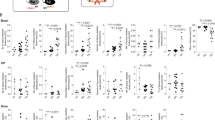Abstract
Intracerebral hemorrhage (ICH) is a devastating disease lacking an effective treatment. While the initial injury occurs within minutes, an inflammatory response contributes to ongoing tissue damage over hours to days. Relatively little is known about leukocyte trafficking into the brain in the hours after ICH onset. Understanding these events may lead to identification of new therapeutic targets. Using the blood injection mouse model of ICH, the numbers of leukocytes in the ipsilateral and contralateral brain were quantified by flow cytometry 12 h after surgery. Perihematomal inflammation was confirmed by histology and chemokines and cytokines in the brain quantified by multiplex ELISA. Few neutrophils were detected in the brain 12 h after ICH. The majority of leukocytes consisted of inflammatory macrophages (CD45.1hiCD3−Ly6G−CD11c−CD11b+Gr1+ cells) and inflammatory dendritic cells (CD45.1hiCD3−Ly6G−CD11cintCD11b+Gr1+ cells). Microglia numbers did not differ between the hemispheres. These results indicate that blood-derived monocyte populations traffic into brain early after ICH and outnumber neutrophils at 12 h.




Similar content being viewed by others
References
Qureshi AI, Mendelow AD, Hanley DF. Intracerebral haemorrhage. Lancet. 2009;373:1632–44.
Wang J, Dore S. Inflammation after intracerebral hemorrhage. J Cereb Blood Flow Metab. 2007;27:894–908.
Kane PJ, Modha P, Strachan RD, Cook S, Chambers IR, Clayton CB, et al. The effect of immunosuppression on the development of cerebral oedema in an experimental model of intracerebral haemorrhage: whole body and regional irradiation. J Neurol Neurosurg Psychiatry. 1992;55:781–6.
Lee ST, Chu K, Jung KH, Kim SJ, Kim DH, Kang KM, et al. Anti-inflammatory mechanism of intravascular neural stem cell transplantation in haemorrhagic stroke. Brain. 2008;131:616–29.
Sansing LH, Kasner SE, McCullough L, Agarwal P, Welsh FA, K. K. Autologous blood injection to model spontaneous intracerebral hemorrhage in mice. Journal of Visualized Experiments 2011; http://www.jove.com/index/Details.stp?ID=2618. Accessed 9 Feb 2012.
Del Bigio MR, Yan H-J, Buist R, Peeling J, del Zoppo GJ. Experimental intracerebral hemorrhage in rats: magnetic resonance imaging and histopathological correlates. Stroke. 1996;27:2312–20.
Xue M, Del Bigio MR. Intracerebral injection of autologous whole blood in rats: time course of inflammation and cell death. Neurosci Lett. 2000;283:230–2.
Gong C, Hoff JT, Keep RF. Acute inflammatory reaction following experimental intracerebral hemorrhage in rat. Brain Res. 2000;871:57–65.
Auffray C, Sieweke MH, Geissmann F. Blood monocytes: development, heterogeneity, and relationship with dendritic cells. Annu Rev Immunol. 2009;27:669–92.
Serbina NV, Salazar-Mather TP, Biron CA, Kuziel WA, Pamer EG. Tnf/inos-producing dendritic cells mediate innate immune defense against bacterial infection. Immunity. 2003;19:59–70.
King IL, Dickendesher TL, Segal BM. Circulating ly-6c + myeloid precursors migrate to the cns and play a pathogenic role during autoimmune demyelinating disease. Blood. 2009;113:3190–7.
Dimitrijevic OB, Stamatovic SM, Keep RF, Andjelkovic AV. Absence of the chemokine receptor ccr2 protects against cerebral ischemia/reperfusion injury in mice. Stroke. 2007;38:1345–53.
Schilling M, Strecker JK, Ringelstein EB, Schabitz WR, Kiefer R. The role of cc chemokine receptor 2 on microglia activation and blood-borne cell recruitment after transient focal cerebral ischemia in mice. Brain Res. 2009;1289:79–84.
Yao Y, Tsirka SE. The CCL2-CCR2 system affects the progression and clearance of intracerebral hemorrhage. Glia. 2012;60(6):908–18.
Auffray C, Fogg D, Garfa M, Elain G, Join-Lambert O, Kayal S, et al. Monitoring of blood vessels and tissues by a population of monocytes with patrolling behavior. Science. 2007;317:666–70.
Nahrendorf M, Swirski FK, Aikawa E, Stangenberg L, Wurdinger T, Figueiredo JL, et al. The healing myocardium sequentially mobilizes two monocyte subsets with divergent and complementary functions. J Exp Med. 2007;204:3037–47.
Martinez FO, Gordon S, Locati M, Mantovani A. Transcriptional profiling of the human monocyte-to-macrophage differentiation and polarization: new molecules and patterns of gene expression. J Immunol. 2006;177:7303–11.
Nakano H, Lin KL, Yanagita M, Charbonneau C, Cook DN, Kakiuchi T, et al. Blood-derived inflammatory dendritic cells in lymph nodes stimulate acute t helper type 1 immune responses. Nat Immunol. 2009;10:394–402.
Anzai A, Anzai T, Nagai S, Maekawa Y, Naito K, Kaneko H, et al. Regulatory role of dendritic cells in post-infarction healing and left ventricular remodeling. Circulation. 2012;125(10):1234–45.
Sansing LH, Harris TH, Welsh FA, Kasner SE, Hunter CA, Kariko K. Toll-like receptor 4 contributes to poor outcome after intracerebral hemorrhage. Ann Neurol. 2011;70:646–56.
Sagar D, Foss C, El Baz R, Pomper MG, Khan ZK, Jain P. Mechanisms of dendritic cell trafficking across the blood–brain barrier. J Neuroimmune Pharmacol. 2012;7(1):74–94.
Xi G, Hua Y, Keep RF, Younger JG, Hoff JT. Systemic complement depletion diminishes perihematomal brain edema in rats. Stroke. 2001;32:162–7.
Hua Y, Wu J, Keep RF, Nakamura T, Hoff JT, Xi G. Tumor necrosis factor-alpha increases in the brain after intracerebral hemorrhage and thrombin stimulation. Neurosurgery. 2006;58:542–50. discussion 542–550.
Mayne M, Ni W, Yan HJ, Xue M, Johnston JB, Del Bigio MR, et al. Antisense oligodeoxynucleotide inhibition of tumor necrosis factor-alpha expression is neuroprotective after intracerebral hemorrhage. Stroke. 2001;32:240–8.
Liesz A, Middelhoff M, Zhou W, Karcher S, Illanes S, Veltkamp R. Comparison of humoral neuroinflammation and adhesion molecule expression in two models of experimental intracerebral hemorrhage. Exp Transl Stroke Med. 2011;3:11.
Carmichael ST, Vespa PM, Saver JL, Coppola G, Geschwind DH, Starkman S, et al. Genomic profiles of damage and protection in human intracerebral hemorrhage. J Cereb Blood Flow Metab. 2008;28:1860–75.
Guillemin GJ, Brew BJ. Microglia, macrophages, perivascular macrophages, and pericytes: a review of function and identification. J Leukoc Biol. 2004;75:388–97.
Renno T, Krakowski M, Piccirillo C, Lin JY, Owens T. Tnf-alpha expression by resident microglia and infiltrating leukocytes in the central nervous system of mice with experimental allergic encephalomyelitis. Regulation by th1 cytokines. J Immunol. 1995;154:944–53.
Jin R, Yang G, Li G. Inflammatory mechanisms in ischemic stroke: role of inflammatory cells. J Leukoc Biol. 2010;87:779–89.
Acknowledgments
This study was supported by NIH 5T32 NS041224 (MDH).
Author information
Authors and Affiliations
Corresponding author
Rights and permissions
About this article
Cite this article
Hammond, M.D., Ai, Y. & Sansing, L.H. Gr1+ Macrophages and Dendritic Cells Dominate the Inflammatory Infiltrate 12 h After Experimental Intracerebral Hemorrhage. Transl. Stroke Res. 3 (Suppl 1), 125–131 (2012). https://doi.org/10.1007/s12975-012-0174-9
Received:
Revised:
Accepted:
Published:
Issue Date:
DOI: https://doi.org/10.1007/s12975-012-0174-9




